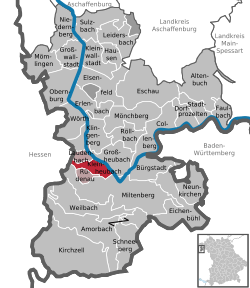Kleinheubach
| Kleinheubach | ||
|---|---|---|
| ||
 Kleinheubach | ||
Location of Kleinheubach within Miltenberg district  | ||
| Coordinates: 49°43′22″N 09°12′52″E / 49.72278°N 9.21444°ECoordinates: 49°43′22″N 09°12′52″E / 49.72278°N 9.21444°E | ||
| Country | Germany | |
| State | Bavaria | |
| Admin. region | Unterfranken | |
| District | Miltenberg | |
| Municipal assoc. | Kleinheubach | |
| Government | ||
| • Mayor | Kurt Schüßler (SPD) | |
| Area | ||
| • Total | 9.49 km2 (3.66 sq mi) | |
| Elevation | 128 m (420 ft) | |
| Population (2012-12-31)[1] | ||
| • Total | 3,671 | |
| • Density | 390/km2 (1,000/sq mi) | |
| Time zone | CET/CEST (UTC+1/+2) | |
| Postal codes | 63924 | |
| Dialling codes | 09371 | |
| Vehicle registration | MIL | |
| Website | www.kleinheubach.de | |
Kleinheubach is a market community in the Miltenberg district in the Regierungsbezirk of Lower Franconia (Unterfranken) in Bavaria, Germany and the seat of the like-named Verwaltungsgemeinschaft (Administrative Community).

Geography
Location
Kleinheubach lies between the Spessart and Odenwald ranges in the Main valley.
History
For a long time there were many Jewish families among the community’s population. They built themselves a synagogue on Gartenstraße. This house of worship was destroyed on Kristallnacht (9 November 1938) and since then the building has been used for other purposes. A memorial plaque does indeed mention the synagogue, but does not go into this story.[2]
Politics
Community council
The council is made up of 17 council members, counting the mayor.
| CSU | SPD | FW | Total | |
|---|---|---|---|---|
| 2008 | 6 | 5 | 6 | 17 seats |
(as at municipal election held on 2 March 2008)
Coat of arms
The community’s arms might be described thus: Argent on a mount of three Or a lion rampant gules armed and langued of the second.
The lordship of Kleinheubach passed after the Counts of Rieneck died out in 1559 to the Counts of Erbach, and again in 1731, through sale, to the Princes of Löwenstein-Wertheim-Rosenberg. At the time of sale, the Princes had to promise that this Protestant place would be allowed unhindered to keep the Augsburg Confession even under their Catholic rule. They had a stately palace built by Johann Dientzenhofer on the site of the former castle, which is still owned by the family today. The lion is taken from this princely family’s arms, in a somewhat simplified form, as it has appeared there since about 1518. The market community’s seal is known from imprints between 1810 and 1840, and shows the same composition, although the lion is in some cases on flat ground rather than the “mount of three” (or Dreiberg, as this device is called in German heraldry).
The arms have been borne since the 19th century.[3]
Economy and infrastructure
Transport
Bundesstraße 469 runs by the community.
Famous people
Sons and daughters of the town
- Joseph von Schork (b. 7 December 1829; d. 25 January 1905), Roman Catholic Archbishop of the Archbishopric of Bamberg from 1890 to 1905
- Wilhelm Kahl (b. 17 June 1849; d. 14 May 1932 in Berlin), German scholar of jurisprudence and politician (DVP), Member of the Reichstag, President of the Deutscher Juristentag
- Helmut Kahlert (b. 7 June 1927; d. 25 January 2009 in Furtwangen), social scientist and clock historian
- Torsten Fenslau (b. 23 April 1964; d. 6. November 1993 in Darmstadt), music producer and disc jockey
References
- ↑ "Fortschreibung des Bevölkerungsstandes". Bayerisches Landesamt für Statistik und Datenverarbeitung (in German). 31 December 2012.
- ↑ Gedenkstätten für die Opfer des Nationalsozialismus. Eine Dokumentation, Band 1. Bundeszentrale für politische Bildung, Bonn 1995, ISBN 3-89331-208-0, S. 155
- ↑ Description and explanation of Kleinheubach’s arms
External links
| Wikimedia Commons has media related to Kleinheubach. |
- This article incorporates information from the German Wikipedia.
